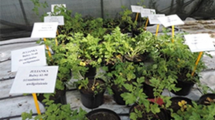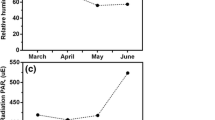Summary
The response of five potato cultivars (Alpha, Cardinal, Désirée, Spunta and Up-to-Date) to a range of amounts of irrigation nitrogen top dressing (N.t.) in a rainless region was studied by means of the line-source sprinkler method. The irrigation-to-evaporation ratio,K p, ranged from 0.14 to 1.27 and N.t. from 12 kg/ha to 201 kg/ha, respectively.
In all cultivars, the yield increased linearly up toK p=1.0; at higher ratios there was a yield decline in all cultivars except for Cardinal, in which the yield function flattened off. Spunta was the highest yielding cultivar (16t/ha) in the dry range (K p=0.14; N.t.=12 kg/ha). Désirée was the highest yielding cultivar (64 t/ha) in the wet range (K p=1.0; N.t.=201 kg/ha), and Alpha was the lowest yielding cultivar in both the dry and wet range (9 and 46 t/ha, respectively).
Leaf permeability, leaf water potential and photosynthesis rate decreased, and tuber dry matter percentage increased with decreasingK p: these indices also varied with plant age, and among cultivars. Yields were adversely affected when soil water potential at the 30-cm depth dropped below −0.4 bar.
Zusammenfassung
Die Reaktion von fünf Kartoffelsorten (Alpha, Cardinal, Désirée, Spunta und Up-to-Date) gegenüber abgestuften Gaben einer Stickstoff-Kopfdüngung (N.t.) mit der Beregnung wurde in der regenlosen Vegetationszeit im nördlichen Negev, Israel, studiert. Die Abstufung der Wasser-N.t., ergab sich durch Anwendung der ‘line-source’-Beregnungsmethode, bei welcher die Menge der Wasser-N.t. mit zunehmender Entfernung der Pflanzenreihen von der Regnerleitung abnimmt (Abb. 1); daraus ergab sich eine weite Abstufung des Beregnungs/Verdunstungs-Koeffizienten (K p) mit 1,27 in der feuchtesten und 0,14 in der trockensten Reihe, und entsprechenden N.t.-Werten von 201 kg/ha bis 12 kg/ha. Die durchschnittliche Bodenfeuchtigkeit in der Wurzelzone nahm ebenfalls mit zunehmender Entfernung von der Regnerleitung ab (Abb. 2).
Verschiedene Indices hinsichtlich der Reaktion auf den Beregnungs-N.t. wurden während der Vegetationszeit registriert: Blattpermeabilität (ein Wert für die Öffnung der Stomata, Tabelle 1), Blattwasser-Potential (Tabelle 2) und Photosyntheserate (Tabelle 3). Alle drei Indices tendierten zur Abnahme mit zunehmendemK p; unter den fünf Sorten ergaben sich Unterschiede in der Reaktion zum Beregnungs-N.t.-Verhältnis. Désirée erreichte höchsten stomatären Öffnungsgrad und höchste Photosyntheserate im nassen Bereich.
Die Knollenerträge stiegen bei Beregnung bis zuK p=1,0 (Tabelle 4). Wasserüberschuss bei allen Sorten ausser Cardinal verursachte etwas Ertragsrückgang. Die Funktion für Ertrag gegenüber Bewässerung konnte entweder quadratisch (y=a+bx−cx 2) für den gesamten Bereich vonK p oder linear (y=a+bx) innerhalb des bereiches unterhalbK p=1,0 beschrieben werden (Tabelle 5). Désirée zeigt den höchsten Ertrag (ca 60t/ha) im feuchten Bereich, Spunta im trockenen Bereich, und Alpha war die Sorte mit dem geringsten Ertrag im gesamten Bereich der Wasserapplikation. Die Erträge wurden stark beeinträchtigt, wenn das Bodenwasserpotential unter −0,4 bar fiel.
Die Trockenmasse der Knollen erhöhte sich mit zurückgehender Wasserapplikation (Tabelle 6); innerhalb dieses Bereiches hatten Alpha den höchsten und Spunta den niedrigsten Trockenmassegehalt.
Mit Ausnahme von Désirée wiesen die verschiedenen untersuchten physiologischen Indices nicht auf das Ertragspotential der Sorten hin; Désirée zeigte im feuchten Bereich höchste Raten für stomatäre Öffnung, Photosynthese und Knollenertrag. Ebensowenig war die Persistenz der Blätter unter Wasserstress in Beziehung zum Knollenertrag: Alpha, die ihre Blätter am längsten beibehielt, produzierte im trockensten Bereich weit weniger (7,9t/ha) als Spunta, eine früh alternde Sorte (16,5 t/ha). Es wird angenommen, dass trotz eines gemeinsamen Reaktionsmusters gegen Wasser-N.t.-Versorgung jede Sorte ihre spezifischen Reaktionsparameter aufweist.
Résumé
La réponse de cinq variétés (Alpha, Cardinal, Désirée, Spunta et Up-to-Date) à différentes doses d'irrigation et d'apport azoté foliaire (N.t.) a été étudié en saison sèche dans le nord du Negev, en Israël. Un gradient d'apport eauazote était obtenu en utilisant un dispositif linéaire d'aspersion par sprinkler, dans lequel les quantités approtées diminuaient avec l'augmentation de la distance entre les rangs et la source d'approvisionnement (fig. 1). Cela permettait d'obtenir une large gamme pour la valeur du coefficientK p irrigation-évaporation allant de 1,27 pour les rangs humides à 0,14 pour les rangs secs, et pour l'apport d'azote allant de 201 kg/ha à 12 kg/ha. L'hygrométrie moyenne dans les zones de développement des racines diminuait également avec l'éloignement des lignes de sprinklers (fig. 2).
Plusieurs caractères physiologiques influencés par l'apport eau-azote étaient étudiés durant la période de croissance des plantes: perméabilité des feuilles (indice d'ouverture des stomates; tableau 1) potentiel hydrique des feuilles (tableau 2) et taux de photosynthèse (tableau 3). Les trois indices tendaient à diminuer avec l'abaissement deK p; les cinq variétés présentaient des différences dans leur réaction vis à vis des quantités approtées d'eau et d'azote. Désirée maintenait un haut niveau d'ouverture des stomates et un taux élevé de photosynthèse dans les rangs humides.
Le rendement en tubercules augmentait avec l'irrigation donnant unK p de 1,0 (tableau 4); l'excès d'eau causait une baisse de rendement pour toutes les variétés sauf Cardinal. La fonction donnèe par la réponse du rendement à l'irrigation pourrait être exprimée soit comme une fonction quadratique (y=a+bx+cx 2) pour la gamme complète duK p, soit comme une fonction linéaire (y=a+bx) à l'intérieur de la gamme située au-dessous deK p=1,0 (tableau 5). Désirée était la variété à plus fort rendement (60 t/ha) dans les gammes humides alors que Spunta l'était dans les gammes sèches; Alpha donnait le rendement le plus faible dans la gamme complète duK p. Le rendement était inversement affecté quand la capacité de rétention d'eau du sol passait au-dessous de −0,4 bar.
La teneur en matière sèche des tubercules augmentait avec l'augmentation des apports d'eau (tableau 6) mais Alpha et Spunta avaient respectivement la plus haute et la plus basse teneur en matière sèche.
Les différents caractères physiologiques étudiés ne donnaient pas d'indications sur le rendement potentiel des variétés, à l'exception de Désirée qui, dans les conditions humides, avait les plus hauts niveaux d'ouverture des stomates, de photosynthèse et de rendement en tubercules. En ce qui concerne ce dernier, dans des conditions de stress hydrique, Alpha, qui maintenait son feuillage le plus longtemps, produisait beaucoup moins en condition sèche (7,9 t/ha) que Spunta, variété à senescence précoce (16,5 t/ha). On en conclut que malgré le mode commun de réponse aux applications eau-fumure, chaque variété possède une réponseà ces paramètres qui lui est spécifique.
Similar content being viewed by others
References
Ackerson, R. R., D. R. Krieg, T. D. Miller & R. G. Stevens, 1977. Water relations and physiological activity of potatoes.Journal of the American Society for Horticultural Science 102: 572–575.
Epstein, E. & W. J. Grant, 1973. Water stress relations of the potato plant under field conditions.Agronomy Journal 65: 400–404.
Gandar, P. W. & C. B. Tanner, 1976. Leaf growth, tuber growth and water potential in potatoes.Crop Science 16: 534–538.
Hanks, R. J., J. Keller, V. P. Rasmussen & G. D. Wilson, 1976. Line-source sprinkler for continuous variable irrigation-crop production studies.Soil Science Society of America, Proceedings 40: 426–429.
McGillivray, J. H., 1950. Effect of irrigation on the production of white potatoes.American Potato Journal 27: 20–23.
Moorby, J., R. Munns & J. Walcott, 1975. Effect of water deficit on photosynthesis and tuber metabolism in potatoes.Australian Journal of Plant Physiology 2: 323–333.
Nissen, M., 1955. The weight of potatoes in water.American Potato Journal 32: 332–334.
Phene, C. J. & D. C. Saunders, 1976. High frequency trickle irrigation and row spacing effect on yield and quality of potatoes.Agronomy Journal 68: 602–607.
Scholander, P. F., H. T. Hammel, E. D. Bradstreet & E. H. Hemmingsen, 1965. Sap pressure in vascular plants.Science 148: 339–346.
Shalhevet, J., D. Shimshi & T. Meir, 1983. Potato irrigation requirements in a hot climate using sprinkler and drip methods.Agronomy Journal 75: 13–16.
Shimshi, D., 1969. A rapid field method for measuring photosynthesis with labelled carbon dioxide.Journal of Experimental Botany 20: 381–401.
Shimshi, D., 1977. A fast reading viscous flow porometer.New Phytologist 78: 593–598.
Shimshi, D., J. Shalhevet & T. Meir, 1983. Irrigation regime effects on some physiological responses of potato (Solanum tuberosum L.).Agronomy Journal 75: 262–267.
Singh, G., 1969. A review of soil-water relations in potatoes.American Potato Journal 46: 398–403.
Susnoschi, M., 1982. Growth and yield studies of potatoes developed in a semi-arid region. I. Yield response of several varieties grown as a double crop.Potato Research 25: 59–69.
Susnoschi, M. & D. Shimshi, 1985. Growth and yield studies of potato developed in a semi-arid region. 2. Effect of water stress and top dressing nitrogen amounts on growth of several varieties.Potato Research 28: 161–176.
Wit, C. T. de, 1958. Transpiration and crop yields.Verslagen van Landbouwkundige Onderzoekingen 54: 1–88.
Author information
Authors and Affiliations
Additional information
Contributon from the Agricultural Research Organization, The Volcani Center, Bet Dagan, Israel. No E-811, 1983 Series.
Rights and permissions
About this article
Cite this article
Shimshi, D., Susnoschi, M. Growth and yield studies of potato development in a semi-arid region. 3. Effect of water stress and amounts of nitrogen top dressing on physiological indices and on tuber yield and quality of several cultivars. Potato Res 28, 177–191 (1985). https://doi.org/10.1007/BF02357443
Accepted:
Issue Date:
DOI: https://doi.org/10.1007/BF02357443




